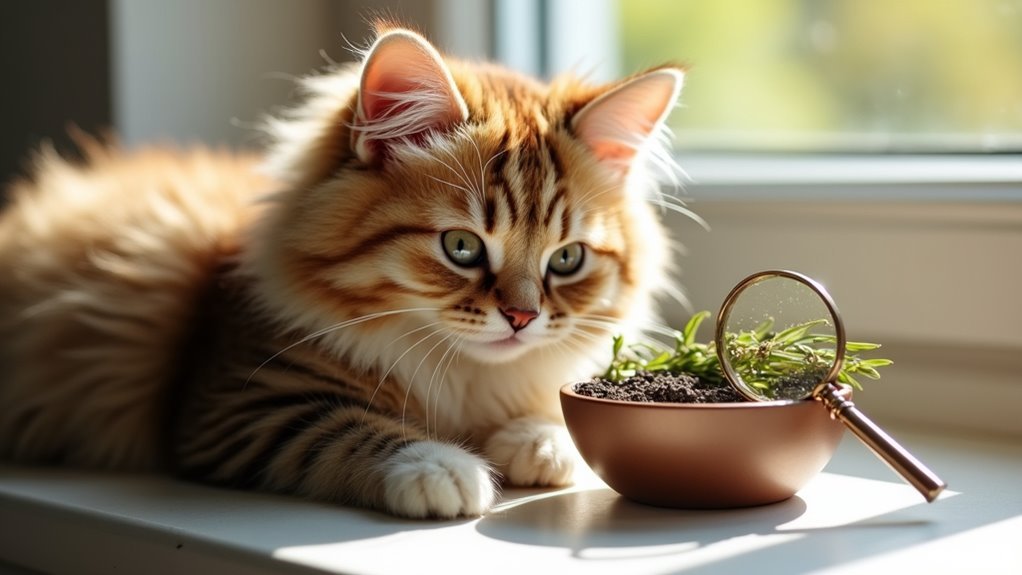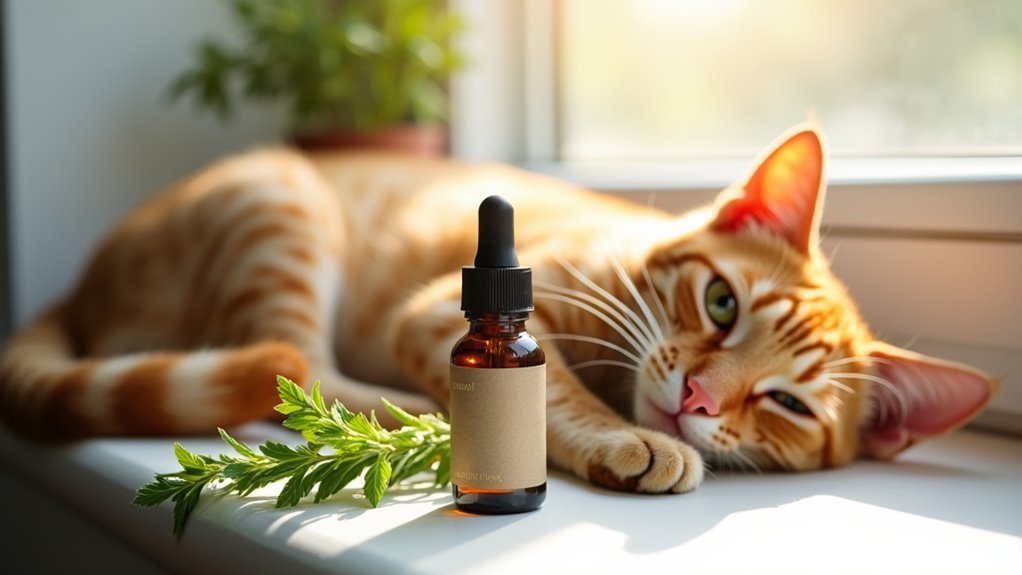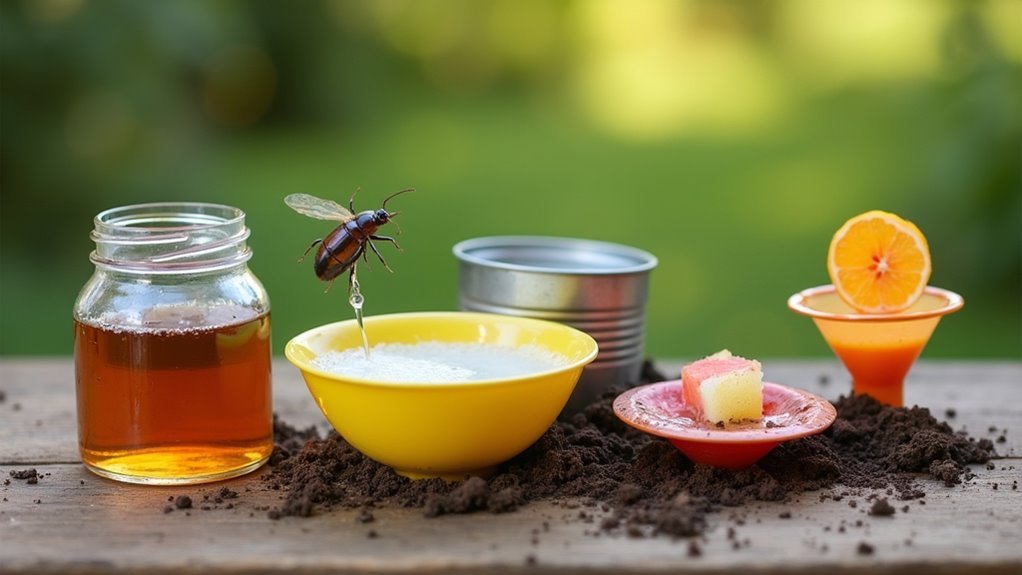If your cat’s constantly scratching, you’re likely dealing with fleas hiding in their groin, ears, and neck folds. Look for tiny black specks resembling pepper in their fur—that’s flea dirt. Before treating, consult your vet to guarantee safety based on your cat’s age and health. Natural solutions like cedar chips, apple cider vinegar spray, and coconut oil can effectively repel and eliminate fleas without harsh chemicals. Discover extensive strategies that’ll protect your feline companion naturally.
Recognizing Flea Infestations in Cats

How can you tell if your cat has fleas when these tiny pests are masters of hide-and-seek? Recognizing fleas starts with watching for continuous scratching and excessive grooming behaviors.
These black or brown insects, smaller than 1/8-inch, hide expertly in dark fur and thick coats. During your inspection, look for flea dirt—tiny black specks that resemble pepper throughout your cat’s fur.
Focus on common hiding spots like the groin, ears, neck folds, and armpits where fleas congregate. Use a strong flashlight and gently comb through the fur to spot these elusive pests or their telltale excrement.
Don’t ignore flea infestations, as they’ll also bite you, causing itchy welts and potential allergic reactions that require prompt attention.
Understanding Flea Behavior and Hiding Spots
You’ll find fleas aren’t randomly scattered across your cat’s body—they strategically choose warm, protected areas like the groin, ears, neck folds, and armpits where they can hide effectively.
Their small size and dark coloring make them particularly challenging to spot, especially if your cat has dark or thick fur.
That’s why knowing where to look and using proper detection techniques can make the difference between catching an infestation early and dealing with a full-blown problem.
Flea Preferred Body Areas
Most fleas gravitate toward specific warm, sheltered areas on your cat’s body where they can hide and feed undisturbed.
You’ll typically find these pests concentrated in the groin, ears, neck folds, and armpits where they’re protected from scratching and grooming.
Since fleas measure less than 1/8-inch long, they’re particularly difficult to spot on cats with dark fur.
During a flea infestation, these parasites spread throughout your cat’s entire body, making early detection vital for effective flea control.
Use a strong flashlight when inspecting these preferred hiding spots, and gently comb through the fur with a flea comb to reveal both live fleas and flea dirt, which confirms their presence.
Detection Challenges and Tips
Detecting fleas on your cat presents unique challenges that go beyond simply knowing where to look.
These tiny parasites are less than 1/8-inch long, making flea detection particularly difficult on cats with dark or thick fur that can effectively conceal infestations.
Here are three essential tips for effective flea detection:
- Use proper tools – A flea comb and strong flashlight will help illuminate and catch fleas in your cat’s fur.
- Look for flea dirt – Those tiny black specks are clear signs of flea presence.
- Conduct regular inspections – Part your cat’s fur with your fingers, focusing on warm hiding spots.
A thorough inspection should include checking for continuous scratching and potential flea bites on humans, which indicate the need for immediate action.
Consulting Your Veterinarian Before Treatment

Before applying any flea treatment to your cat, scheduling a consultation with your veterinarian guarantees you’re choosing the safest and most effective approach. Consulting your veterinarian assures your pet health remains protected while addressing the infestation properly.
Your vet will assess your cat’s specific needs based on age, weight, and medical history to recommend the most effective method. This professional guidance prevents exposure to products toxic to cats, particularly those containing permethrins found in many over-the-counter options.
| Veterinary Benefits | DIY Risks |
|---|---|
| Tailored flea treatments for cats | Generic, potentially harmful products |
| Professional diagnosis confirmation | Misidentification of the problem |
| Preventive care education | Limited knowledge of prevention |
Your veterinarian can also address any flea-related health complications and provide thorough prevention strategies.
Cedar Chips as a Natural Deterrent
You can harness cedar’s natural flea-repelling scent to create a chemical-free barrier around your cat’s environment.
Cedar chips work effectively when you place them strategically around your pet’s bedding and favorite resting spots, as fleas naturally avoid the wood’s strong aroma.
However, you’ll need to follow specific safety guidelines to guarantee these natural deterrents protect rather than harm your feline companion.
Cedar’s Flea-Repelling Properties
While commercial flea treatments flood the market with chemical solutions, cedar chips offer a natural alternative that harnesses nature’s own pest-repelling properties.
These aromatic wood pieces emit a distinct scent that fleas find absolutely repulsive, making cedar chips an effective natural deterrent you can trust around your feline companion.
Cedar’s ability to repel fleas stems from three key properties:
- Strong aromatic compounds that create an unwelcoming environment for fleas
- Long-lasting scent retention that provides continuous protection when properly maintained
- Multi-purpose benefits that freshen your home while deterring pests
The non-toxic nature of cedar chips makes them a safe alternative for households with pets and children, unlike harsh chemical treatments that may pose health risks.
Safe Application Methods
Proper placement transforms cedar chips from a simple household item into an effective flea-fighting tool. These safe application methods guarantee maximum effectiveness while protecting your cat’s health.
Spread cedar chips around your cat’s bedding, sleeping areas, and favorite lounging spots. You can also place them near doorways and in corners where fleas commonly hide.
Since cedar chips are non-toxic, you won’t worry about harmful side effects if your cat investigates them. However, never use cedar essential oil, which poses serious health risks.
This natural flea deterrent works best when you refresh the chips regularly to maintain their potent scent. The pleasant aroma will enhance your home’s atmosphere while creating an unwelcoming environment for fleas seeking to establish themselves.
Lemon-Based Flea Control Methods

Since citric acid naturally repels and kills fleas, lemon-based flea control methods offer an effective alternative to harsh chemical treatments for your cat.
Unlike essential oils that require careful safe use considerations, lemons provide natural flea and tick prevention without overwhelming your pet’s sensitive system.
Here’s how to implement these natural flea solutions:
- Create lemon spray – Boil sliced lemons in water, steep overnight, then spray on bedding to exterminate fleas and eggs.
- Add lemon juice to laundry – Enhance pest control properties when washing pet bedding without fabric damage.
- Apply regularly – Multiple treatments maintain effectiveness against infestations.
Rosemary and Cumin for Flea Prevention
When you’re seeking gentle yet effective flea prevention methods, rosemary and cumin offer powerful natural solutions that work both externally and internally to protect your cat.
Rosemary’s natural scent repels fleas effectively – you can sprinkle ground dried leaves in common areas or steep them in water for spray applications. Mix dried rosemary into your cat’s bedding to create a protective barrier against fleas.
Sprinkle ground rosemary in common areas or steep in water for spray applications to naturally repel fleas.
Cumin works as an internal deterrent when mixed into your cat’s food, helping repel fleas from within.
Both herbs are completely safe for cats when used appropriately, providing a natural alternative to harsh chemical treatments. Regular use prevents flea infestations while adding pleasant aromas to your home, making this flea prevention approach both effective and enjoyable.
Apple Cider Vinegar Treatment Applications
Apple cider vinegar provides another accessible household remedy that complements herbal flea prevention methods perfectly. This natural treatment for cats offers a safe way to help get rid of unwanted pests while supporting your pet’s health through gentle, non-toxic applications.
To use apple cider vinegar as an effective flea and tick preventative:
- Spray Application: Mix two parts vinegar with one part water in a spray bottle and apply to your cat’s coat to repel fleas.
- Bedding Treatment: Add vinegar to laundry when washing your cat’s bedding to eliminate fleas and eggs.
- Regular Prevention: Use consistently as a preventive measure alongside other natural treatments.
Dish Soap Flea Elimination Techniques
Another effective household solution involves using ordinary dish soap to eliminate fleas through direct contact methods. The soap breaks down flea exoskeletons when you apply it to your wet cat’s skin and hair, particularly in flea-prone areas.
Start by thoroughly wetting your cat’s coat, then gently lather the dish soap and rinse completely to prevent skin dryness.
You can also create a flea trap by placing shallow dishes of warm soapy water near light sources, as fleas are naturally drawn to illumination and will drown in the solution.
Always monitor your cat for skin irritation after treatment and consult your veterinarian if adverse reactions occur.
Combining dish soap treatments with other preventive measures enhances overall flea control effectiveness for lasting results.
Lavender and Chamomile Soothing Solutions
You’ll find that lavender offers powerful flea-fighting properties while simultaneously soothing your cat’s irritated skin.
Chamomile tea works similarly – you can apply the cooled liquid directly to your cat’s coat to repel fleas and calm inflamed areas.
These gentle, natural remedies provide dual benefits that address both the flea problem and your pet’s comfort needs.
Lavender’s Flea-Fighting Properties
When dealing with persistent flea problems, lavender emerges as one of nature’s most effective and gentle solutions for your feline companion. This aromatic herb’s strong scent naturally repels fleas while providing therapeutic benefits for your cat’s skin and overall comfort.
You can harness lavender’s power through these simple methods:
- Fresh Lavender Steep – Steep fresh lavender in hot water to create a potent flea-repelling base.
- Cooling Process – Allow the mixture to cool completely before application.
- Spray Application – Transfer to a spray bottle for easy coat application.
This soothing spray offers a gentle approach to flea prevention without harsh chemicals.
Regular application supports holistic flea management, ensuring your cat stays comfortable while maintaining natural protection against these persistent pests.
Chamomile Tea Application Method
Building upon lavender’s effectiveness, chamomile tea offers another gentle yet powerful approach to flea management that doubles as a skin-soothing treatment for your cat.
You’ll prepare this natural remedy by steeping 1-2 tea bags or several tablespoons of dried chamomile flowers in two cups of boiling water for 10-15 minutes, then straining the mixture.
Once completely cooled, apply the chamomile tea directly to your cat’s coat. This treatment helps repel fleas while working to soothe irritated skin caused by flea bites.
The calming properties of chamomile reduce your cat’s stress during flea treatments, making the application process smoother for both of you. Regular use promotes overall skin health and helps manage flea populations naturally.
Skin Soothing Benefits
Beyond their flea-repelling capabilities, both lavender and chamomile deliver exceptional skin-soothing benefits that address the secondary effects of flea infestations.
When your cat’s skin becomes inflamed from constant scratching and biting, these natural remedies provide gentle relief that works alongside your primary flea treatments.
The skin-healing properties include:
- Reduced inflammation – Chamomile’s anti-inflammatory compounds calm reddened, swollen areas where fleas have bitten.
- Itch relief – Lavender’s natural compounds help soothe the persistent irritation that drives your cat to scratch excessively.
- Stress reduction – Both herbs’ calming scents help reduce your cat’s anxiety during treatment periods.
Regular application of cooled chamomile tea or lavender-infused water enhances your cat’s comfort while supporting overall skin health throughout the flea elimination process.
Coconut Oil and Physical Flea Removal
While chemical treatments dominate the flea control market, coconut oil offers a gentle yet effective natural alternative that you can safely use on your cat.
Apply coconut oil directly onto your cat’s coat after using flea shampoo, massaging it thoroughly into flea-prone areas. The oil works by smothering fleas while providing moisturizing benefits to irritated skin.
Combine this treatment with a flea comb for enhanced flea removal. As you comb through the oiled fur, you’ll physically capture fleas that the oil has weakened. Immediately dunk caught fleas in soapy water to kill them.
This dual approach guarantees thorough elimination while promoting a healthy coat. Regular coconut oil application maintains skin health and helps prevent future infestations naturally.
Safety Considerations for Natural Treatments
Although natural flea treatments offer safer alternatives to harsh chemicals, you’ll need to exercise caution when selecting and applying these remedies to your cat.
Significant safety considerations include understanding that not all natural ingredients are safe—lavender oil can be toxic if cats ingest large amounts.
Follow these essential safety steps:
- Consult a veterinarian before starting any treatment to verify it’s appropriate for your cat’s specific health needs.
- Monitor for adverse reactions after application, including skin irritation or allergic responses.
- Apply treatments more frequently since natural solutions typically don’t last as long as synthetic alternatives.
Even though natural flea treatments containing geraniol, peppermint oil, and thyme oil are generally safer, careful observation remains vital for your cat’s wellbeing.
Frequently Asked Questions
How Do You Get Rid of Fleas Without Harming Cats?
You can bathe your cat with gentle dish soap, use diluted apple cider vinegar spray, comb regularly with a flea comb, and place cedar chips near bedding while avoiding toxic essential oils.
What Repels Fleas but Is Safe for Cats?
You can use cedar chips, rosemary, and lemon to repel fleas safely around cats. Apple cider vinegar spray, diluted essential oils like lavender, and coconut oil also work effectively without harming your feline.
What Household Flea Treatment Is Safe for Cats?
You can safely treat fleas using dish soap lathered into your cat’s wet coat, then rinsed thoroughly. Apple cider vinegar mixed with water also works when sprayed directly onto their fur.
What Kills Fleas on Cats Naturally?
You can kill fleas naturally on your cat using diluted apple cider vinegar spray, gentle dish soap baths, or coconut oil application. Essential oils like lavender and rosemary also effectively repel these pests.
In Summary
You’ve learned several safe, natural methods to combat fleas on your cat. Remember to consult your vet before trying any treatment, even natural ones. Start with gentle approaches like cedar chips or lavender solutions before moving to more intensive methods. Watch your cat’s reaction to each treatment and discontinue if you notice any irritation. Consistency is key—you’ll need to treat both your cat and their environment for lasting results.





Leave a Reply